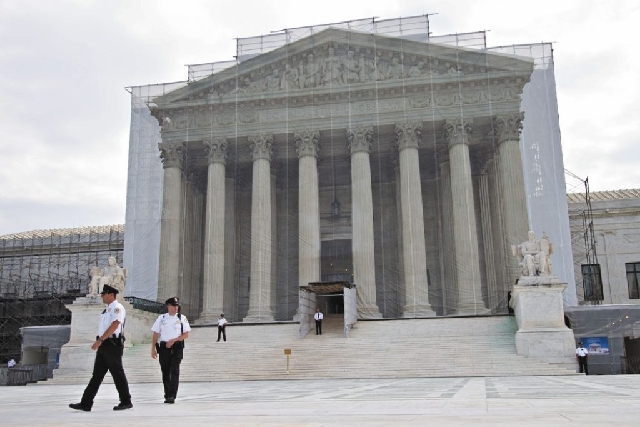Affirmative action survives Supreme Court review
WASHINGTON — Affirmative action in college admissions survived Supreme Court review Monday in a consensus decision that avoided the difficult constitutional issues surrounding a challenge to the University of Texas admission plan.
Justice Anthony Kennedy wrote the court’s 7-1 ruling that said a court should approve the use of race as a factor in admissions only after it concludes “that no workable race-neutral alternatives would produce the educational benefits of diversity.”
But the decision did not question the underpinnings of affirmative action, which the high court last reaffirmed in 2003. Kennedy was a dissenter in the ruling in Grutter v. Bollinger in 2003.
The Texas ruling seemed certain to generate more challenges to race-conscious admissions plans, even as civil rights advocates celebrated that the door on affirmative action had not been slammed shut. One indication that the court did not decide anything of great moment Monday came from the lineup of justices who joined Kennedy’s opinion.
Both Justice Sonia Sotomayor, who has gratefully acknowledged the role of affirmative action in her education at Princeton University and Yale Law School, and Justice Clarence Thomas, an affirmative action opponent who has said he felt stigmatized by the racial preference that helped him get into the same law school as Sotomayor, sided with Kennedy on Monday. Thomas also wrote separately to say he would have gone further and overturned the court’s 2003 ruling.
But the justices did not take that dramatic step. Instead, they said the federal appeals court in New Orleans did not apply the highest level of judicial scrutiny when it upheld the Texas plan, which uses race as one among many factors in admitting about a quarter of the university’s incoming freshmen. The school gives the bulk of the slots to Texans who are admitted based on their high-school class rank, without regard to race.
The high court ordered the appeals court to take another look at the case of Abigail Fisher, a white Texan who was not offered a spot at the university’s flagship Austin campus in 2008. Fisher has since received her undergraduate degree from Louisiana State University.
Justice Ruth Bader Ginsburg was the lone dissenter. “In my view, the courts below adhered to this court’s pathmarking decisions and there is no need for a second look,” Ginsburg said in a dissent she read aloud.
Justice Elena Kagan stayed out of the case, presumably because she had some contact with it at an earlier stage when she worked in the Justice Department.
Kennedy said that courts must determine that the use of race is necessary to achieve the educational benefits of diversity, the Supreme Court’s standard for affirmative action in education since 1978. The high court most recently reaffirmed the constitutionality of affirmative action in the 2003 case, which involved the University of Michigan.
“As the Court said in Grutter, it remains at all times the university’s obligation to demonstrate, and the judiciary’s obligation to determine, that admissions processes `ensure that each applicant is evaluated as an individual and not in a way that makes an applicant’s race or ethnicity the defining feature of his or her application’,” Kennedy said.
University of Texas president Bill Powers said the university plans no immediate changes in its admissions policies as a result of Monday’s ruling and will continue to defend them in the courts.
“We remain committed to assembling a student body at the University of Texas at Austin that provides the educational benefits of diversity on campus while respecting the rights of all students and acting within the constitutional framework established by the court,” Powers said.
But Edward Blum, who helped engineer Fisher’s challenge, said it is unlikely that the Texas plan and many other college plans can long survive. “The Supreme Court has established exceptionally high hurdles for the University of Texas and other universities and colleges to overcome if they intend to continue using race preferences in their admissions policies, said Blum, director of The Project on Fair Representation in Alexandria, Va.
Marvin Krislov, who was general counsel for the University of Michigan during the last affirmative action case and is now president of Oberlin College in Ohio, said he read the decision as “a strong affirmation of the importance of student body diversity in higher education, by a strong, strong majority of the court. That’s the most important takeaway of the case.”
At the same time, Sherrilyn Ifill, president of the NAACP Legal Defense and Educational Fund, acknowledged that the decision will require courts to examine affirmative action plans more closely. “Grutter leaves more space and the court is closing that space,” Ifill said.
Retired Justices Sandra Day O’Connor and John Paul Stevens, both members of the majority in the Grutter case, were in the courtroom Monday for the Texas decision.
The challenge to the Texas plan gained traction in part because the makeup of the court has changed since the last time the justices ruled on affirmative action in higher education in 2003. Then, O’Connor wrote the majority opinion that held that colleges and universities can use race in their quest for diverse student bodies.
O’Connor retired in 2006, and her replacement, Justice Samuel Alito, has shown himself to be more skeptical of considerations of race in education.
Texas automatically offers about three-quarters of its spots to high-school graduates based on their class rank as part of what was called the “top 10 percent” plan under a 1990s state law signed by then-Gov. George W. Bush. Since then the program has been changed so that now only the top 8 percent gain automatic admission.
Race is a factor in filling out the rest of the incoming class. More than 8 in 10 African-American and Latino students who enrolled at the flagship campus in Austin in 2011 were automatically admitted, according to university statistics.
In all, minorities accounted for just over half of the incoming freshman class, with a quarter of the class made up of blacks and Hispanics.
The university said the extra measure of diversity it gets from the slots outside automatic admission is crucial because too many of its classrooms have only token minority representation, at best. At the same time, Texas argued that race is one of many factors considered and that whether race played the key role in any applicant’s case was impossible to tell.
The high court said lower courts must not rely on Texas’ good faith in accepting those claims, but must instead demand proof.
The Obama administration, roughly half of the Fortune 100 companies and large numbers of public and private colleges that feared a broad ruling against affirmative action backed the Texas program. Among the benefits of affirmative action, the administration said, is that it creates a pipeline for a diverse officer corps that it called “essential to the military’s operational readiness.” In 2003, the court cited the importance of a similar message from military leaders.
In other action Monday, the justices:
-Ruled along ideological lines for employers in two workplace race-based discrimination cases, drawing another dissent from Ginsburg that called on Congress to undo the conservative majority’s decisions.
-Agreed to review a federal appeals court decision that found President Barack Obama violated the Constitution when he bypassed the Senate last year to appoint three members of the National Labor Relations Board.
-Ruled generic drug manufacturers can’t be sued in state court for a drug’s design defects if federal officials approved the brand-name version the generic drug copied.
-Said they would consider reviving an Environmental Protection Agency regulation intended to reduce power plant emissions that cause pollution in neighboring states.
-Rejected challenges to EPA decisions allowing an increase in ethanol content in gasoline.
-Decided to reconsider the constitutionality of a 2007 Massachusetts law that bars protests in 35-foot “buffer zones” around abortion clinic entrances, exits and driveways.
-Ruled that a convicted military sex offender who completed his sentence can be prosecuted for not updating his whereabouts in a federal sex offender database, even though that law was passed after he finished serving his sentence and was discharged from the military.
The justices will issue more opinions on Tuesday. Disputes over gay marriage and the Voting Rights Act are among the six cases remaining.
---
AP Education Writer Justin Pope contributed to this report from Ann Arbor, Mich.
---
Follow Mark Sherman on Twitter at: HTTP://WWW.TWITTER.COM/SHERMANCOURT




























